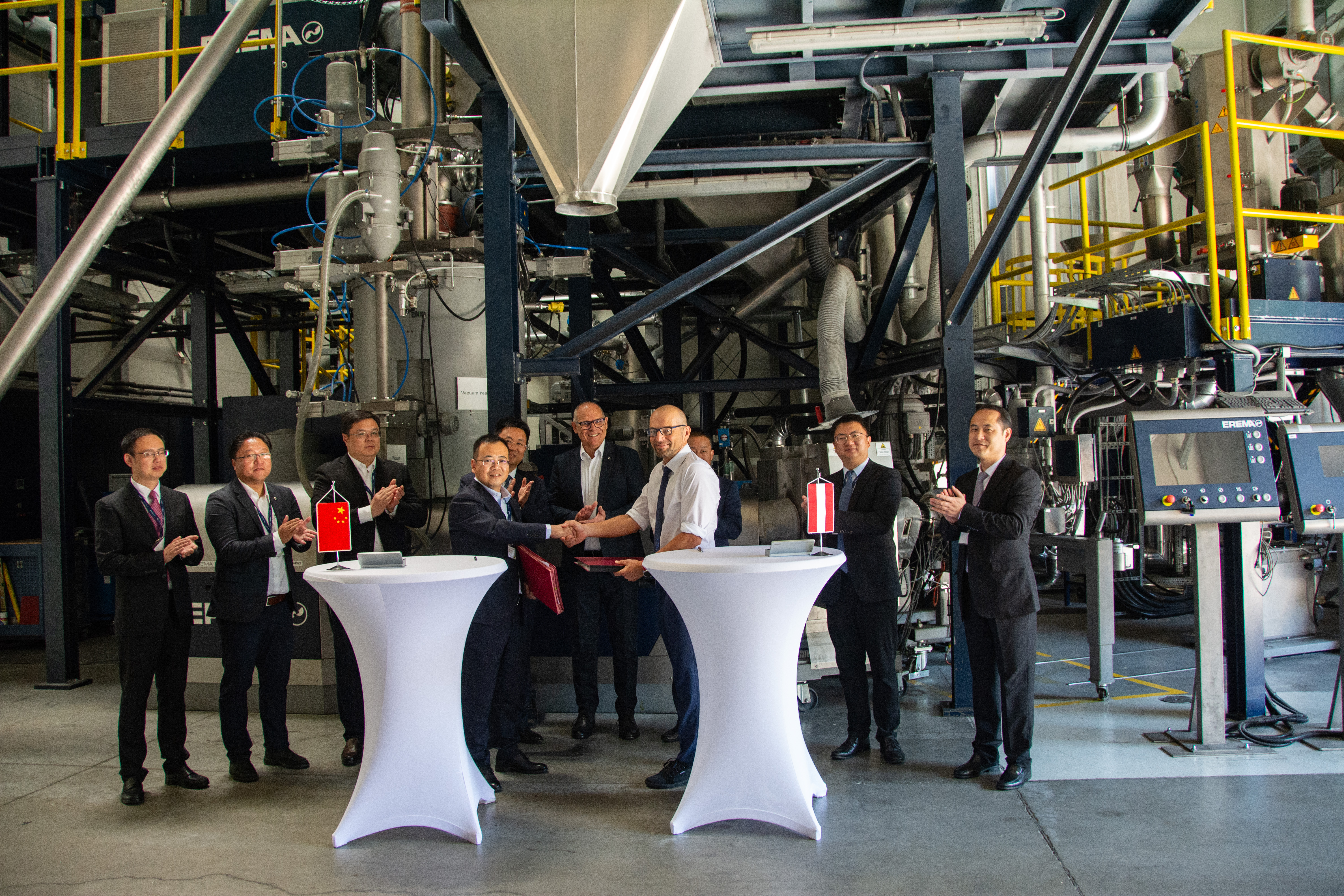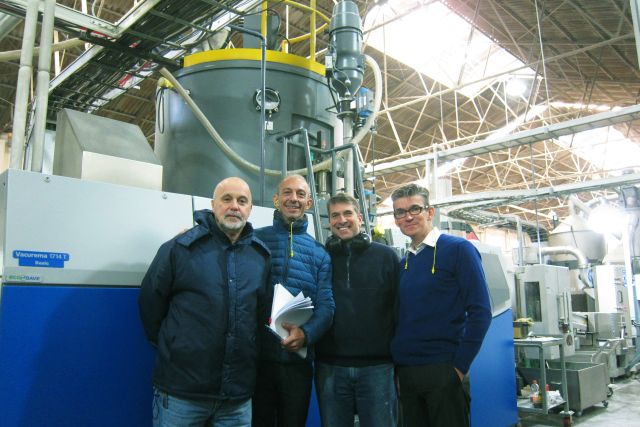"Transparent PET packaging has been a popular discussion topic with regard to food packaging for years," says Gregor Schleicher. "Even though APET films for this application have been commodity products for a long time, we still have a few specialities to offer to our customers." The CEO of Buergofol GmbH, which has its headquarters in Siegenburg, and Kurt Stark, Director Business Development, explain why the film manufacturer primarily uses recycled material to produce PET films and which machine technology the use for it. K-PROFI met both of them at the company's second site in Ingolstadt.
"We are the only full-range supplier in Europe for refrigerated display case items," emphasises Gregor Schleicher, and continues: "We extrude APET films and combine these with shrink or skin films and especially peel, seal and reclose top films. The top films are also mostly printed and laminated. Here we are the only film manufacturer who produces its own laminate films for PET itself. The company produces around 25,000 t/a of rigid APET film in thicknesses ranging from 150 to 900 µm with widths up to 1,600 mm on three flat film lines in total.
97% of all film produced is used in direct food contact, for meat, fish, cheese and poultry, for example. This also applies to the flexible films which Buergofol produce using common raw materials such as PE, PP, EVOH and PA. A total of eight blown film extrusion lines are available for the 15,000 t/a of flexible film which produce the 3- to 14-layer products in thicknesses ranging from 30 to 400 µm and with a width of up to 2.4 m.
Buergofol has a clear focus on commodity products and supplies its customers with wound film with a variety of thicknesses and product specifications in quantities up to 1.5 t. And the company does it very successfully. "We could sell more than we produce right now. This is why we are investing in new lines," says Kurt Stark, describing the current situation and naming the future goal: "We would like to ramp up our production capacities in both the cast and blown film sectors by around 50 per cent in each segment over the coming years." Further to this, Buergofol is not ruling out the opening of another location besides Neutraubling, Ingolstadt and Siegenburg.
Top after-sales service
"One of our specialities is the manufacturing of 3-layer PET film with a middle layer made of post-consumer material," explains CEO Gregor Schleicher. The company decided to invest in an EREMA system in connection with this a good eight years ago and combine it with a cast film part from SML. "And we have no regrets." On the contrary. The company has just placed an order for the second complete system as they not only find the process and the end product convincing, they are also extremely satisfied with the service.
"The two mechanical engineering companies from Austria set the standard, especially when it comes to after-sales service," says Gregor Schleicher with praise, "it is seldom the case with others that we experience service that is so good." Like the existing lines, the new one, which is due to be installed and commissioned in September, will have an overall capacity of up to 2,200 kg/h and produce films with a net width of 1,300 to 2,200 mm. Depending on the application, the new line will also process virgin material in addition to mainly post-consumer material, i.e. washed bottle flakes from the single-use and reusable deposit system. "We have been working together with a number of fixed suppliers where we know the quality and can rely on regular deliveries," the CEO confirms.
He sees no problems of any kind for the future, either, in terms of material procurement and the increasing demand. In reply to the question why Buergofol produces film from PCR materials, Gregor Schleicher has a straight answer: "Sustainability is of course a very important topic for us, but this is just one of the reasons why we process PCR material with this plant technology. It enables us to process inhouse scrap such as edge trim in a direct way, which also has a positive impact on sustainability. Moreover, films made of PCR have a clear advantage: they are somewhat stiffer than films made from pure virgin material which, on the one hand, makes for better thermoformability and, on the other hand, allows you to keep the films a little thinner." A 220 µm film made of recycled post-consumer material, for example, is roughly on a par with a 260 µm film made of virgin material.
Reactor with various tasks
To process the bottle flakes, material mixtures are produced first in large silos and scrap inhouse materials are also added. "Some of our customers also mix the recycling material with up to 30 per cent virgin material," explains Christoph Wöss, Business Development Manager - Application Bottle at EREMA. The mixture then goes from the silo via a vacuum conveyor first into a sluice which has a volume of around 85 l. Here the pressure is already reduced from atmospheric pressure to a first vacuum stage. The material then goes into the reactor which has a total volume of approximately 11.5 m3 where it stays for around 1 to 2 hours. Christoph Wöss: "The dwell time in this application is crucial, especially for the approval of the material by EFSA for food contact use, because besides moisture removal, decontamination in particular has to take place.”
Wöss explains the processes inside the reactor in more detail. To begin with the material is heated up to a temperature of around 190°C by friction alone. Three processes occur while heating takes place. Firstly, there is crystallisation, which ensures that the flakes do not stick to each other in the further processing. Then there is moisture removal. "The outside moisture of PCR material is between 0.3 and 1 per cent. This evaporates at the temperature inside the reactor within seconds or a few minutes." The inside moisture of the PET at around 0.2 to 0.3% is likewise removed, thus ensuring that hydrolysis cannot occur and the chain length of the polymer molecules is not shortened. "Finally there is the third process of decontamination. Contaminants are likewise discharged as a result of the high temperature and removed reliably by the vacuum which is applied."
In conclusion Christoph Wöss mentions another benefit of the reactor: "Bottles have become increasingly thinner especially just recently, due to ecological and economical reasons, meaning that the bulk density of the flakes is decreasing more and more. This, in turn, is bad for the extruder later on." In the heat there is a bulk density increase of around 250 kg/m3 to 500 kg/m3. The material leaves the reactor after about two hours and is fed into a single-screw extruder with a diameter of 212 mm.
Single-screw extruder has benefits
The single-screw extruder now handles the task of melting the prepared material at a temperature of around 280°C and conveying it through a piston filter which retains the solid contaminants and into the flat sheet die. "This complete process has a multitude of benefits, especially for the processing of secondary raw materials," says a convinced Gregor Schleicher. "The flakes are completely freed from moisture and contaminants at relatively moderate temperatures and are clean when they enter the single-screw extruder. Here they are only exposed to the high temperatures very briefly due to the pre-cleaning, which has a positive impact on material properties. He is of the opinion that this system is better compared to the multiple screw systems without preparation. This solution is also good in terms of energy, as shown by research projects at the SKZ institute. "The specific electricity consumption of the EREMA solution is lowest in comparison to alternative systems."
After the flat sheet die the PET film is cooled down in the SML calender and laminated directly inline if required. "We work with thermolamination, so without additional adhesive," emphasises Kurt Stark. Buergofol attaches great importance in general to inline thermolamination, which is not very common for PET film. "We have designed our inline laminating stations and integrated them in the systems as a whole ourselves so far."
SML has now directly integrated the laminating station in the new plant which will again be a combination of an EREMA recycling system and an SML cast part. "The machine technology has progressed," says the delighted film manufacturer, who is very proud that they produce all the films specified by the market themselves apart from OPET and OPP films. In order to ensure that the film products satisfy the customers' wishes, Buergofol operates a fully equipped test laboratory and a thermoforming technical centre. "This is where we reproduce the processes of our customers," says Gregor Schleicher in conclusion.
Text: Karin Regel, editor K-PROFI
| Application: | PET bottle-to-bottle PET inline applications PET inline sheet |
|---|---|
| Materials: | PET bottle flakes PET flat film production waste PET skeleton production waste PET virgin material |
| Product category: | VACUREMA |
| Modell Details: | VACUREMA® Basic Inline Sheet |

Strong partnership drives plastics recycling in China
Jiangsu Ceville New Materials Technology Co, Ltd, a leading Chinese recycling company, signed the purchase of another VACUREMA® plant in June 2024.

Buenos Aires, Argentina
The Argentinian company RECICLAR is continuing its success story as a South American pioneer in 2017, too. Following the successfully established business fields of PET flakes and PET recyclates ...